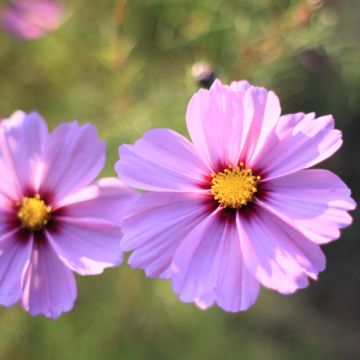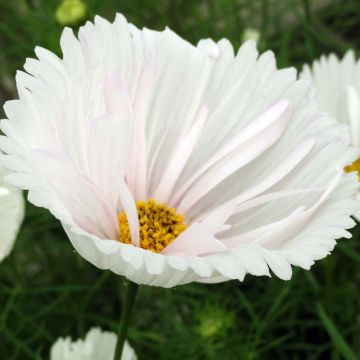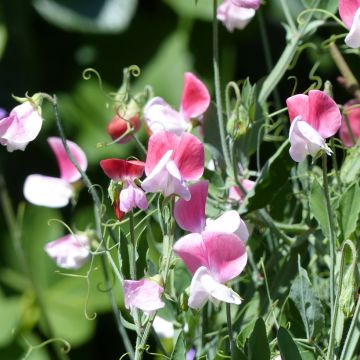

Cosmos sulphureus Bright Lights Mix - seeds
Cosmos sulphureus Bright Lights Mix - seeds
Cosmos sulphureus Bright Lights Mix
Sulphur Cosmos, Yellow Cosmos, Orange Cosmos
Special offer!
Receive a €20 voucher for any order over €90 (excluding delivery costs, credit notes, and plastic-free options)!
1- Add your favorite plants to your cart.
2- Once you have reached €90, confirm your order (you can even choose the delivery date!).
3- As soon as your order is shipped, you will receive an email containing your voucher code, valid for 3 months (90 days).
Your voucher is unique and can only be used once, for any order with a minimum value of €20, excluding delivery costs.
Can be combined with other current offers, non-divisible and non-refundable.
Home or relay delivery (depending on size and destination)
Schedule delivery date,
and select date in basket
This plant carries a 6 months recovery warranty
More information
We guarantee the quality of our plants for a full growing cycle, and will replace at our expense any plant that fails to recover under normal climatic and planting conditions.
Would this plant suit my garden?
Set up your Plantfit profile →
Description
Cosmos sulphureus 'Bright Lights Mix' ensures a long and intense flowering with shimmering shades of orange and yellow. These are undemanding annual plants, known for their easy cultivation and rapid growth to form a bushy, erect and branched clump, adorned with finely cut dark green foliage. During summer and until autumn, its bright flowers attract many pollinators, including bees and butterflies, contributing to the biodiversity and biological balance of the garden. The exuberant and intense flowering brings brightness and charm to flower beds, borders, pots and meadows. They gracefully enrich romantic and rustic gardens, harmoniously mingling with perennial plants, bulbs and roses, while offering an inexhaustible source of flowers for making various floral compositions. Sown in March and transplanted in April, they will begin flowering from mid-June. The seeds come from organic farming.
Cosmos sulphureus, also known as Sulphur Cosmos, Mexican Cosmos, or Klondike Cosmos, belongs to the asteraceae family. Native to Mexico and widely distributed in Africa and Asia, it is considered an invasive plant in the United States and Brazil. This not very hardy annual plant, related to Dahlias, shows a characteristic flower head and coarser foliage than the bipinnate cosmos (Cosmos bipinnatus). It has a branched habit and finely cut, light green, ferny leaves and flowers constantly from June to the first frost. The flowers have dyeing properties, producing an orange-yellow dye which was used in Native American cultures and later in southern Africa to dye wool.
The 'Bright Lights' variety forms a branched clump about 0.60 to 0.70 m tall, with a spread of 0.30 to 0.40 m. The stems bear fine, 15 to 20 cm long ferny leaves with five pinnate lobes to the central vein, in a pretty light green. They emit a light and pleasant fragrance. It begins flowering around June-July, approximately 80 to 90 days after sowing, and continues until mid-autumn. The semi-double flower heads measure 6 to 8 cm in diameter and have pleated and toothed petals in shades of yellow, golden yellow, bright orange or vermilion red, surrounding a golden yellow central disk. The flowers have very good vase life, able to last 7 to 10 days without losing their brightness. After flowering, the plant produces blackish conical seeds, seed-grown plants may differ from their parent. The flower petals are edible and can enhance salads with their spicy taste.
The Cosmos Bright Lights Mix blends perfectly with other varieties of Cosmos and can be easily associated with different plants such as perennial salvias, Buenos Aires verbena, Tree Mallow, Cleomes, Common Mallow, Peruvian Heliotrope or Love-in-a-Mist. Despite its delicate appearance, it is robust and easy to maintain. It will flower without difficulty, regardless of the conditions: modest soil, heat, humidity... As long as it receives sunlight.
An ecological asset: Throughout the summer, the nectar-rich flowers of Cosmos attract pollinating insects, butterflies and birds to your garden. A good way to improve the ecosystem and promote fruit and vegetable production in your vegetable garden. Tip: At the end of the season, let the plants dry naturally on the stem; this will provide seeds for birds, especially goldfinches.
Organic or "AB" seeds come from plants grown in organic farming (without using phytosanitary products). They undergo no treatment after harvest. These seeds are suitable for organic market gardening.
Report an error about the product description
Flowering
Foliage
Plant habit
Botanical data
Cosmos
sulphureus
Bright Lights Mix
Asteraceae
Sulphur Cosmos, Yellow Cosmos, Orange Cosmos
Cultivar or hybrid
Other Cosmos seeds
View all →Planting and care
The seeds of Sulphur Cosmos are small: about 120 per gram. There are two possible methods of sowing:
Sowing under cover, before transplanting and planting in open ground: Sow from March to May, at a depth of 2 or 3 mm, in fine compost and cover the seeds with a very fine pinch of vermiculite. Place the seed tray in a propogator at a temperature of 18-25°C, or wrap it in a polythene bag. Keep the soil moist, but not waterlogged. Light promotes germination, which occurs 7 to 21 days after sowing. When the seedlings are large enough to handle, transplant them into individual pots with a diameter of 7 cm. Grow them in cooler conditions until the plants are sufficiently developed to be planted outside. When all risk of frost has passed, gradually acclimatise the plants to outdoor conditions for 7 to 10 days. Plant them in full sun, in moist, well-drained soil, spaced 25 to 40 cm apart. Pinch the tips of the shoots on each stem during transplantation to encourage branching and the production of numerous flowers.
Direct sowing in open ground: This is easier and can be done from May to June, after the last frost. Sow the seeds spaced apart in prepared soil, covering them with about 2 mm of a light substrate. Germination takes approximately 10 to 20 days. Once the young seedlings reach the stage of 4 to 6 leaves, thin them out to leave one plant every 20 to 30 cm.
Cosmos prefer a soil pH between 6 and 8.5, corresponding to the soil of their original habitat, the alkaline regions of Central America. They prefer full sun but tolerate partial shade. These plants are drought-tolerant once established, they are not very susceptible to diseases but can be targeted by aphids. Self seeding is common but not always true to type.
Sowing period
Intended location
This item has not been reviewed yet - be the first to leave a review about it.
Similar products
Haven't found what you were looking for?
Hardiness is the lowest winter temperature a plant can endure without suffering serious damage or even dying. However, hardiness is affected by location (a sheltered area, such as a patio), protection (winter cover) and soil type (hardiness is improved by well-drained soil).

Photo Sharing Terms & Conditions
In order to encourage gardeners to interact and share their experiences, Promesse de fleurs offers various media enabling content to be uploaded onto its Site - in particular via the ‘Photo sharing’ module.
The User agrees to refrain from:
- Posting any content that is illegal, prejudicial, insulting, racist, inciteful to hatred, revisionist, contrary to public decency, that infringes on privacy or on the privacy rights of third parties, in particular the publicity rights of persons and goods, intellectual property rights, or the right to privacy.
- Submitting content on behalf of a third party;
- Impersonate the identity of a third party and/or publish any personal information about a third party;
In general, the User undertakes to refrain from any unethical behaviour.
All Content (in particular text, comments, files, images, photos, videos, creative works, etc.), which may be subject to property or intellectual property rights, image or other private rights, shall remain the property of the User, subject to the limited rights granted by the terms of the licence granted by Promesse de fleurs as stated below. Users are at liberty to publish or not to publish such Content on the Site, notably via the ‘Photo Sharing’ facility, and accept that this Content shall be made public and freely accessible, notably on the Internet.
Users further acknowledge, undertake to have ,and guarantee that they hold all necessary rights and permissions to publish such material on the Site, in particular with regard to the legislation in force pertaining to any privacy, property, intellectual property, image, or contractual rights, or rights of any other nature. By publishing such Content on the Site, Users acknowledge accepting full liability as publishers of the Content within the meaning of the law, and grant Promesse de fleurs, free of charge, an inclusive, worldwide licence for the said Content for the entire duration of its publication, including all reproduction, representation, up/downloading, displaying, performing, transmission, and storage rights.
Users also grant permission for their name to be linked to the Content and accept that this link may not always be made available.
By engaging in posting material, Users consent to their Content becoming automatically accessible on the Internet, in particular on other sites and/or blogs and/or web pages of the Promesse de fleurs site, including in particular social pages and the Promesse de fleurs catalogue.
Users may secure the removal of entrusted content free of charge by issuing a simple request via our contact form.
The flowering period indicated on our website applies to countries and regions located in USDA zone 8 (France, the United Kingdom, Ireland, the Netherlands, etc.)
It will vary according to where you live:
- In zones 9 to 10 (Italy, Spain, Greece, etc.), flowering will occur about 2 to 4 weeks earlier.
- In zones 6 to 7 (Germany, Poland, Slovenia, and lower mountainous regions), flowering will be delayed by 2 to 3 weeks.
- In zone 5 (Central Europe, Scandinavia), blooming will be delayed by 3 to 5 weeks.
In temperate climates, pruning of spring-flowering shrubs (forsythia, spireas, etc.) should be done just after flowering.
Pruning of summer-flowering shrubs (Indian Lilac, Perovskia, etc.) can be done in winter or spring.
In cold regions as well as with frost-sensitive plants, avoid pruning too early when severe frosts may still occur.
The planting period indicated on our website applies to countries and regions located in USDA zone 8 (France, United Kingdom, Ireland, Netherlands).
It will vary according to where you live:
- In Mediterranean zones (Marseille, Madrid, Milan, etc.), autumn and winter are the best planting periods.
- In continental zones (Strasbourg, Munich, Vienna, etc.), delay planting by 2 to 3 weeks in spring and bring it forward by 2 to 4 weeks in autumn.
- In mountainous regions (the Alps, Pyrenees, Carpathians, etc.), it is best to plant in late spring (May-June) or late summer (August-September).
The harvesting period indicated on our website applies to countries and regions in USDA zone 8 (France, England, Ireland, the Netherlands).
In colder areas (Scandinavia, Poland, Austria...) fruit and vegetable harvests are likely to be delayed by 3-4 weeks.
In warmer areas (Italy, Spain, Greece, etc.), harvesting will probably take place earlier, depending on weather conditions.
The sowing periods indicated on our website apply to countries and regions within USDA Zone 8 (France, UK, Ireland, Netherlands).
In colder areas (Scandinavia, Poland, Austria...), delay any outdoor sowing by 3-4 weeks, or sow under glass.
In warmer climes (Italy, Spain, Greece, etc.), bring outdoor sowing forward by a few weeks.

















































